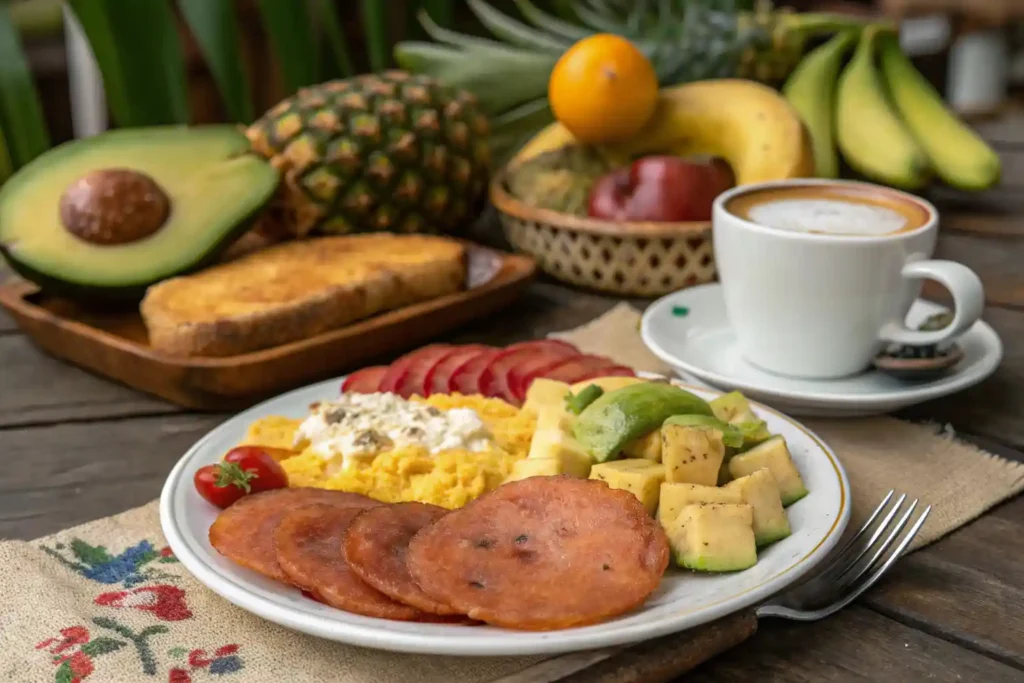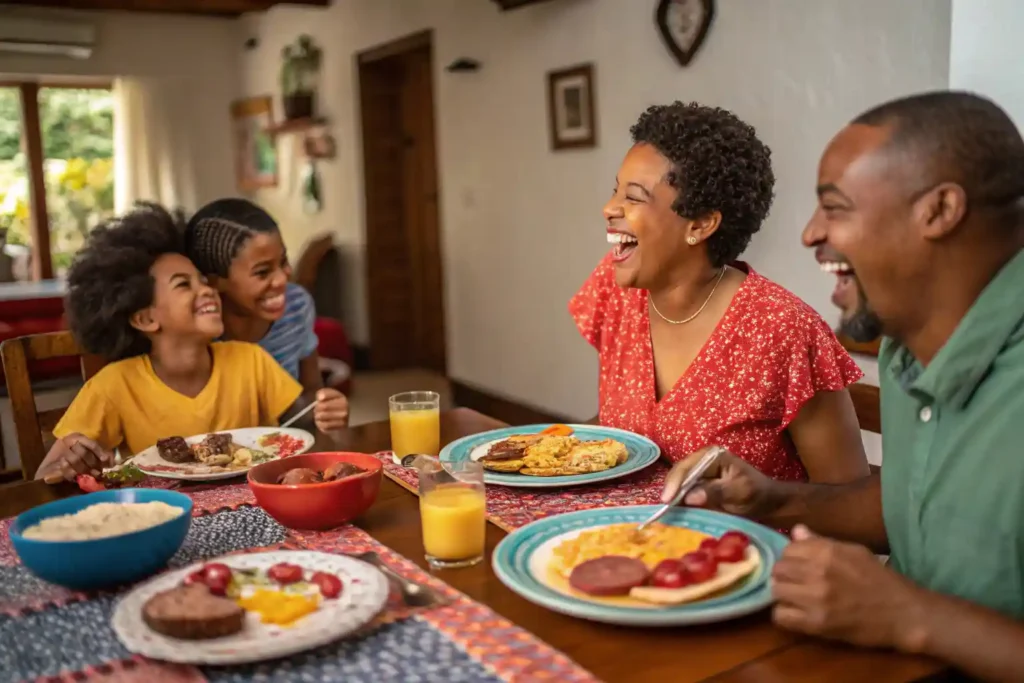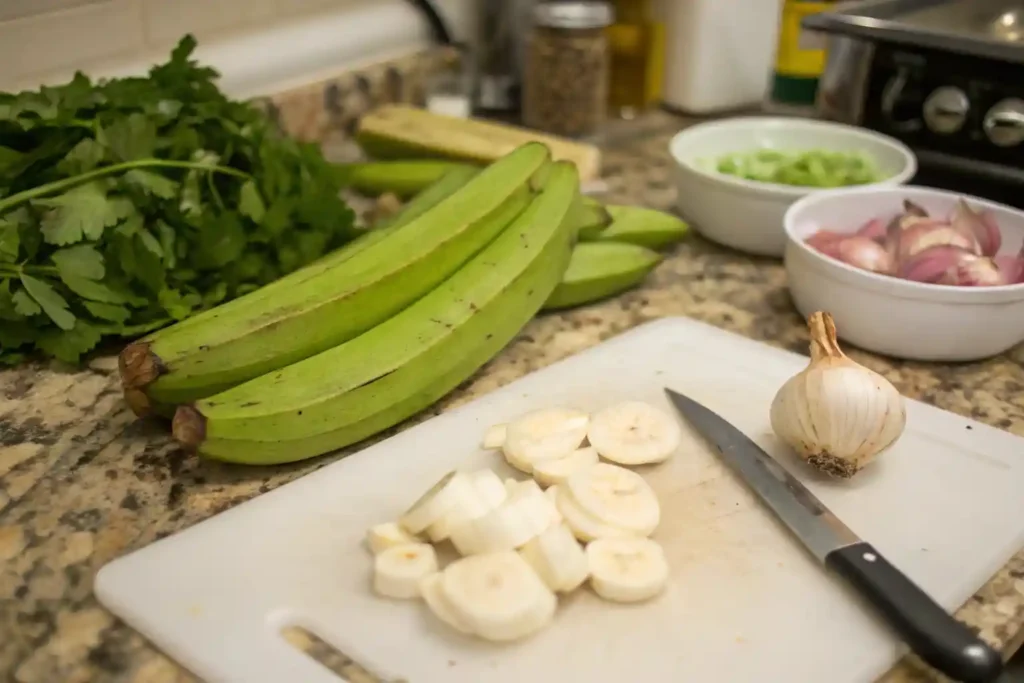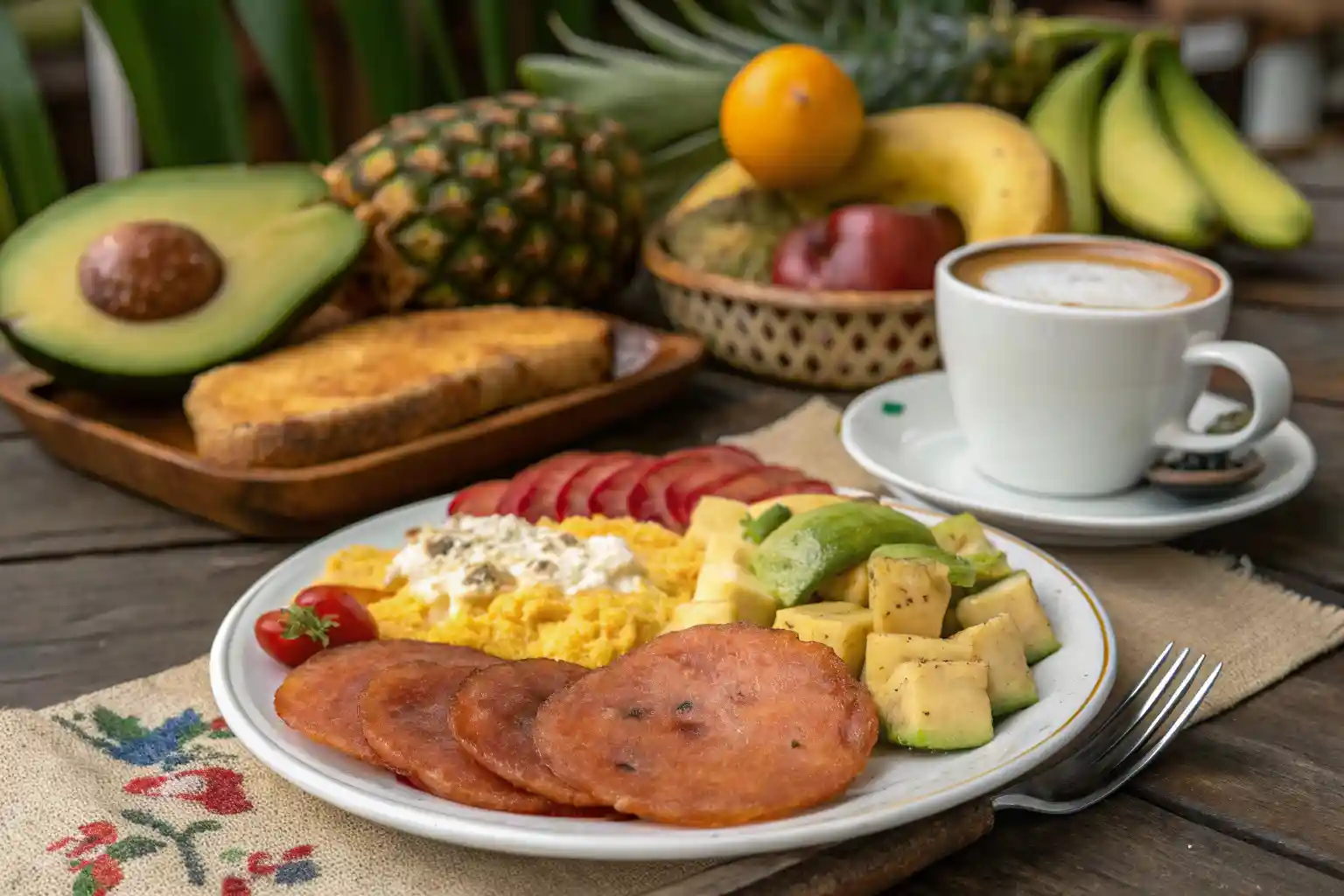Dominican breakfast is a vibrant celebration of flavors and traditions. From mangu to tostones, these dishes reflect the rich culinary heritage of the Dominican Republic, offering a delicious start to the day that is both hearty and satisfying.
Table of contents
1. What is a Typical Dominican Breakfast?

1.1 Key Components
First, Mangu: A staple dish made from boiled and mashed green plantains, often served with various accompaniments.
Next, Salami and Eggs: A common pairing, where fried salami is served alongside scrambled or fried eggs, adding protein and flavor.
Additionally, Fried Cheese: This is a popular addition, providing a crispy texture and rich taste that complements the other dishes.
Moreover, Avocado: Slices of fresh avocado are often included, adding creaminess and a healthy touch to the meal.
1.2 Cultural Significance

In addition, the breakfast culture in the Dominican Republic is deeply rooted in family and tradition. Breakfast is often a communal meal, where families gather to enjoy food and share stories, setting a positive tone for the day. Furthermore, breakfast is a time for families to connect and enjoy each other’s company. Moreover, many dishes have historical significance, reflecting the influences of African, Spanish, and Taino cultures.
1.3 Common Beverages
To accompany breakfast, Dominicans often enjoy:
- Café Dominicano: A strong, rich coffee that is a staple in many households.
- Natural Juices: Freshly squeezed juices from local fruits like orange, pineapple, or passion fruit.
2. Traditional Dominican Breakfast Dishes

Traditional Dominican breakfast dishes are a celebration of local ingredients and culinary techniques. Here are some of the most beloved options:
2.1 Mangu
- Preparation: Made from green plantains, boiled until soft, and then mashed with butter and salt.
- Serving Style: Often served with tres golpes (three hits), which includes fried cheese, salami, and eggs.
- Variations: Some people add onions or garlic for extra flavor.
2.2 Tostones
- Description: Twice-fried green plantains that are crispy on the outside and soft on the inside.
- Serving Suggestions: Typically served with a garlic dipping sauce or as a side to other breakfast dishes.
- Cultural Importance: Tostones are not only a breakfast item but also a popular snack throughout the day.
2.3 Sancocho
- Overview: A hearty stew made with various meats and root vegetables, often enjoyed on special occasions.
- Breakfast Variation: While typically a lunch or dinner dish, some families enjoy a lighter version for breakfast.
- Ingredients: Common ingredients include chicken, beef, yucca, and plantains, simmered in a flavorful broth.
3. Is Mangú Only for Breakfast?
Mangú is a versatile dish that is often associated with breakfast, but its consumption extends beyond the morning meal.
3.1 Breakfast Staple
- Common Pairings: Mangú is traditionally served with fried eggs, salami, and cheese, making it a hearty breakfast option.
- Cultural Perception: Many Dominicans view mangú as a quintessential breakfast food, often reminiscing about family breakfasts centered around this dish.
3.2 Other Meal Occasions
- Lunch and Dinner: Mangú can also be enjoyed for lunch or dinner, often paired with grilled meats or stews.
- Leftovers: Some families prepare extra mangú to enjoy later in the day, showcasing its versatility.
3.3 Popularity Beyond Borders
- Regional Variations: While mangú is primarily Dominican, similar dishes can be found in other Caribbean countries, each with its own unique twist.
- Culinary Influence: The popularity of mangú has spread beyond the Dominican Republic, with many people around the world embracing this delicious dish.
4. What is Mangú Tres Golpes Made Of?
Mangú tres golpes is a quintessential Dominican breakfast dish that showcases the simplicity and richness of Dominican cuisine. This dish is not only delicious but also embodies the cultural significance of breakfast in the Dominican Republic.
4.1 Ingredients of Mangú Tres Golpes
- Green Plantains: The base of the dish, green plantains are boiled and mashed to create a smooth, creamy texture.
- Fried Cheese: Typically made from a firm cheese like queso blanco, it is sliced and fried until golden brown, adding a savory crunch.
- Fried Salami: Dominican salami is a unique type of sausage that is sliced and fried, providing a rich, meaty flavor.
- Eggs: Usually scrambled or fried, eggs add protein and complement the other flavors in the dish.
4.2 Preparation Method
- Boil the Plantains: Start by peeling and cutting the green plantains into chunks. Boil them in salted water until they are soft.
- Mash the Plantains: Drain the plantains and mash them with a bit of butter or olive oil, adding salt to taste. The consistency should be smooth and creamy.
- Fry the Cheese and Salami: In a separate pan, fry the cheese slices until they are golden and crispy. Do the same with the salami slices.
- Cook the Eggs: Scramble or fry the eggs in the same pan, seasoning them lightly with salt and pepper.
- Serve: Plate the mangú and top it with the fried cheese, salami, and eggs. It’s often garnished with sautéed onions for added flavor.
4.3 Cultural Significance
Mangú tres golpes is more than just a meal; it represents the heart of Dominican breakfast culture. It is often enjoyed on weekends or special occasions when families gather to share a hearty meal. The combination of flavors and textures makes it a beloved dish that resonates with many Dominicans, both at home and abroad.
5. Is Mangú Dominican or Puerto Rican?
The question of whether mangú is Dominican or Puerto Rican often arises due to the similarities between the two cuisines. While both cultures have their own versions of mashed plantains, the origins and preparations differ.
5.1 Origins of Mangú
- Dominican Roots: Mangú is a traditional dish in the Dominican Republic, deeply embedded in its culinary history. It is often served as a breakfast staple and is a symbol of Dominican identity.
- Puerto Rican Variations: In Puerto Rico, a similar dish called mofongo is made from fried green plantains, which are mashed and mixed with garlic, pork, and other ingredients. While both dishes use plantains, the preparation and flavor profiles are distinct.
5.2 Cultural Context
- Dominican Breakfast Culture: In the Dominican Republic, mangú is typically served with tres golpes and is a common breakfast choice. It reflects the country’s agricultural heritage and the importance of plantains in the local diet.
- Puerto Rican Cuisine: Mofongo, on the other hand, is often served as a side dish or main course, showcasing the influence of African and Spanish culinary traditions in Puerto Rican cooking.
5.3 Culinary Influence
- Shared Ingredients: Both dishes highlight the versatility of plantains, a staple ingredient in Caribbean cuisine. They demonstrate how different cultures can adapt similar ingredients to create unique culinary experiences.
- Cultural Exchange: The culinary traditions of the Dominican Republic and Puerto Rico have influenced each other over the years, leading to a rich tapestry of flavors and dishes that celebrate their shared heritage.
6. What is the Number One Food in the Dominican Republic?
When discussing the number one food in the Dominican Republic, many would argue that it is rice and beans, often served with meat and salad. This dish is a staple in Dominican households and reflects the country’s agricultural abundance.
6.1 Rice and Beans: A Staple Dish
- Ingredients: The dish typically consists of white rice, black beans (or red beans), and a protein source such as chicken, beef, or pork. It is often accompanied by a fresh salad and fried plantains.
- Preparation: The rice is cooked separately, while the beans are simmered with spices, garlic, and onions to create a flavorful sauce. The two are served together, creating a balanced and satisfying meal.
6.2 Cultural Significance
- Daily Meal: Rice and beans are consumed daily by many Dominicans, making it a fundamental part of their diet. It is often served for lunch and dinner, showcasing its versatility.
- Celebration of Community: This dish is commonly prepared for family gatherings, celebrations, and special occasions, symbolizing unity and togetherness.
6.3 Variations Across the Country
- Regional Differences: Different regions of the Dominican Republic may have their own variations of rice and beans, incorporating local ingredients and flavors. For example, coastal areas might include seafood, while mountainous regions may focus on heartier meats.
- Accompaniments: Common side dishes include fried plantains, avocado, and a fresh salad, enhancing the overall meal experience.
7. The Role of Breakfast in Dominican Culture
Breakfast in the Dominican Republic is more than just a meal; it is a cherished tradition that plays a significant role in daily life. Understanding this cultural context enhances the appreciation of the dishes served.
7.1 Family Gatherings
- Communal Experience: Breakfast is often a time for families to come together, share stories, and enjoy each other’s company. This communal aspect fosters strong family bonds and creates lasting memories.
- Weekend Rituals: Many families reserve special breakfasts for weekends, where they prepare larger meals and enjoy leisurely mornings together.
7.2 Celebrations and Special Occasions
- Holidays and Festivals: During holidays and festivals, breakfast dishes may be elevated with special ingredients or served in larger quantities to accommodate gatherings. Traditional foods are often prepared to honor cultural heritage.
- Cultural Significance: Certain dishes may be associated with specific celebrations, such as mangú during family reunions or sancocho during festive occasions.
7.3 Influence of Other Cultures
- Culinary Fusion: The Dominican Republic’s history of cultural exchange has led to a fusion of flavors and techniques in breakfast dishes. African, Spanish, and Taino influences are evident in the ingredients and preparation methods.
- Adaptation and Innovation: As Dominican cuisine evolves, new breakfast dishes are created, incorporating international flavors while maintaining traditional roots.
8. Exploring Other Popular Dominican Breakfast Dishes
While mangu and tostones are well-known, there are many other delicious breakfast options worth exploring. Here are a few more popular dishes:
8.1 Arepas
- Description: Arepas are cornmeal cakes that can be grilled, baked, or fried. They are often filled with cheese, eggs, or meats, making them a versatile breakfast option.
- Regional Variations: While arepas are popular in various Latin American countries, the Dominican version often includes local ingredients and flavors.
8.2 Yuca con Mojo
Additionally:
- “Overview: Yuca, or cassava, is boiled and served with a garlic and citrus sauce known as mojo. This dish is hearty and flavorful, often enjoyed as a side with breakfast. Additionally, yuca is a staple in Dominican cuisine, and its preparation reflects traditional cooking methods passed down through generations.”
Furthermore:
- “Overview: Yuca, or cassava, is boiled and served with a garlic and citrus sauce known as mojo. This dish is hearty and flavorful, often enjoyed as a side with breakfast. Furthermore, yuca is a staple in Dominican cuisine, and its preparation reflects traditional cooking methods passed down through generations.”
Moreover:
- “Overview: Yuca, or cassava, is boiled and served with a garlic and citrus sauce known as mojo. This dish is hearty and flavorful, often enjoyed as a side with breakfast. Moreover, yuca is a staple in Dominican cuisine, and its preparation reflects traditional cooking methods passed down through generations.”
9. Tips for Enjoying Dominican Breakfast at Home
If you’re inspired to recreate a Dominican breakfast at home, here are some tips to help you get started:
9.1 Sourcing Ingredients
To begin with, local markets: Visit local markets or grocery stores that specialize in Latin American products to find authentic ingredients like green plantains, salami, and Dominican cheese.
Additionally, fresh produce: Use fresh, high-quality ingredients to enhance the flavors of your dishes. For example, look for ripe avocados, fresh herbs, and seasonal fruits.
9.2 Cooking Techniques
- Traditional Methods: Embrace traditional cooking methods, such as boiling, frying, and mashing, to achieve authentic flavors. Don’t be afraid to experiment with different techniques to find what works best for you.
- Family Recipes: If you have Dominican friends or family, ask for their favorite recipes or cooking tips. Family recipes often carry unique flavors and techniques that make the dishes special.
9.3 Presentation
- Colorful Plating: When serving your Dominican breakfast, focus on presentation. Use colorful ingredients like fresh avocado, vibrant plantains, and bright salads to create an appealing plate.
- Cultural Touches: Incorporate traditional serving styles, such as using clay dishes or wooden utensils, to enhance the cultural experience.
Conclusion
In conclusion, exploring the rich and diverse world of Dominican breakfast dishes reveals not only delicious flavors but also a deep cultural significance. From the beloved mangu to the crispy tostones, each dish tells a story of tradition and community. As you enjoy these meals, consider pairing them with insights from related articles like the Best Breakfast Meats: Hearty Meal for a protein boost, or try a Quick Delicious Breakfast Pizza for a fun twist on morning meals. For those seeking healthier options, the Healthy Breakfast Burrito can provide a nutritious alternative while still celebrating the joy of breakfast. Embrace the flavors and traditions of Dominican cuisine, and let each meal be a celebration of culture and family.

